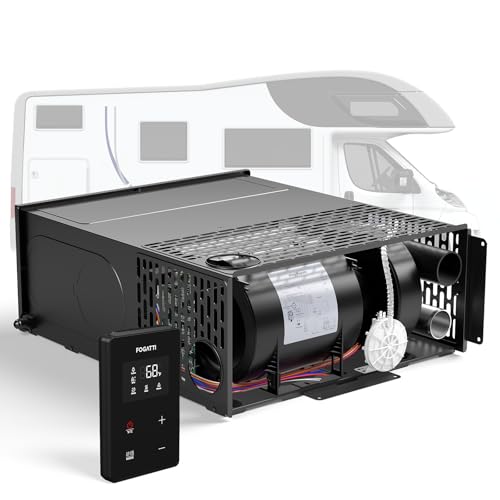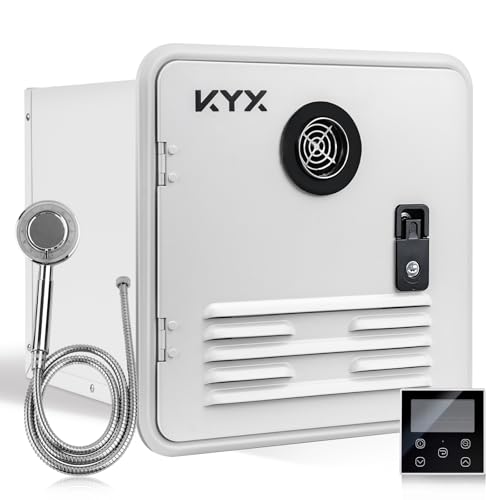Choosing the best heater for your camper depends on whether you need reliable space heating, on-demand hot water, or a combination. Below is a quick comparison of the five selected units covered in this guide, followed by detailed product sections and a practical buying guide.
| Product | Type | Key Feature |
|---|---|---|
| FOGATTI 35,000 BTU Quiet RV Furnace | Space Furnace | High BTU output, multiple modes, 4 power levels |
| Mr. Heater Portable Buddy MH9BX | Portable Propane Space Heater | Infrared radiant heat, safety tip-over switch |
| Caframo True North Heater | Electric Space Heater | Low-profile, quiet, adjustable thermostat |
| Kohree RV Tankless Water Heater 60,000 BTU | Tankless Water Heater | Instant hot water, 2.9 GPM, high-altitude mode |
| KYX RV Tankless Water Heater 67,000 BTU | Tankless Water Heater | High output 3.9 GPM, dual outlets, shower kit |
Content Navigation
FOGATTI 35,000 BTU Quiet RV Furnace

This RV furnace is designed as a direct replacement or upgrade for campers, travel trailers and motorhomes needing higher continuous heating capacity. The unit lists a maximum 35,000 BTU output with four power levels adjustable down to 17,000 BTU, and delivers up to 260 CFM airflow for faster space warm-up.
Key features include three control modes (quick heat, standard, sleep) and a fault monitor for troubleshooting. The upgraded heat exchanger emphasizes efficiency and longevity. Manufacturer notes indicate output air temperatures up to 176°F and suitability for sub-zero operation.
What It Suits: Larger campers or cold-climate travel where central furnace performance and distributed ducted airflow are needed. Requires professional or experienced installation and proper propane hookup and venting.
Mr. Heater Portable Buddy MH9BX

Call 888-896-7031 for Free Local HVAC Quotes – Compare and Save Today!
The Mr. Heater Portable Buddy is an infrared propane radiant heater intended as a portable supplemental heater. It delivers adjustable output from 4,000 to 9,000 BTU and is rated to heat up to roughly 225 sq ft depending on insulation and ambient temperature.
Important safety and convenience features include a Piezo igniter for match-free start, a tip-over safety switch with audible engagement, and oxygen depletion sensor (ODS) variants on some models. The radiant design heats objects and people directly rather than solely conditioning air.
What It Suits: Campers who need quick portable heat, spot heating at campsites, or backup warmth when shore power isn’t available. Requires proper ventilation and adherence to indoor propane safety guidelines.
Caframo True North Electric Heater

The Caframo True North is a compact electric heater with an adjustable thermostat, five settings and a low-profile steel housing. It emphasizes quiet operation and offers steady heat and higher output circulation modes for enclosed spaces.
Unique features: an anti-freeze setting that automatically engages at around 38°F to prevent freezing during storage, and multiple fan/heating modes for climate control. Built-in thermal controls and durable construction suit repeated use in small living areas.
Call 888-896-7031 for Free Local HVAC Quotes – Compare and Save Today!
What It Suits: Campers with reliable shore power or in-vehicle AC systems who prefer electric heating without combustion. Ideal for mild climates, supplemental heat, or frost protection when the camper is unattended.
Kohree RV Tankless Water Heater 60,000 BTU

The Kohree 60,000 BTU model is a propane tankless water heater designed for RVs and campers. It claims an instant hot water supply at up to 2.9 gallons per minute and includes safety features like boil-dry protection, flame shutdown detection, overheating protection, and anti-freeze device.
Operational notes include a low water pressure start-up (1.45 PSI required) and a high-altitude suitability mode. The listed features point to comprehensive electronic protections and thermostatic controls to maintain selected output temperature.
What It Suits: Families or groups using showers and sinks frequently in a camper where continuous hot water and compact installation are priorities. Requires proper propane, water and 12V DC connections per RV plumbing codes.
KYX RV Tankless Water Heater 67,000 BTU

The KYX 67,000 BTU unit positions itself as a high-output on-demand water heater producing up to 3.9 GPM, and includes a 15″ door and shower kit in the listing. It features dual water outlets (front and rear) for indoor/outdoor use and is advertised as compatible with many OEM openings.
Additional notes: the model highlights universal replacement compatibility with major RV heater brands and a remote controller for temperature convenience. High-altitude operation and safety-oriented staged combustion are also mentioned in related product descriptions.
What It Suits: Campers who prioritize powerful, continuous hot water for showers, multiple simultaneous draws, or outdoor rinse use. Installation requires correct venting, propane hook-up, and adherence to RV water heater electrical requirements.
Buying Guide: How To Choose The Right Camper Heater
Selecting a camper heater requires matching heat source, capacity, safety, and installation to your vehicle and travel style. Below are the key considerations to evaluate before purchase.
1. Identify Your Heating Needs
- Space Heating vs. Water Heating: Space heaters (furnaces, portable propane, electric) warm living areas; tankless water heaters provide on-demand hot water. Choose based on primary need.
- Coverage Area: Check BTU or square-foot guidance. A 35,000 BTU RV furnace suits larger motorhomes; portable units (4,000–9,000 BTU) suit small cabins or spot heating.
2. Heat Source And Fuel Type
- Propane Furnaces/Tankless: Common in RVs for space heating and water heating—high output and off-grid capable but require ventilation and gas plumbing.
- Electric Heaters: Quiet and safe for enclosed use with shore power; limited if no AC hookup or inverter capacity.
- Portable Radiant Propane: Provides direct warmth without shore power; consider oxygen depletion sensors and indoor-safe ratings.
3. Capacity And Sizing
- Compare BTU ratings to camper size and insulation. Over-sizing wastes fuel and can cause short cycling; under-sizing fails to maintain comfort.
- For water heaters, compare GPM (gallons-per-minute) and outlet temperature control relative to your showerheads and simultaneous use.
4. Safety Features
- Look for ODS (oxygen depletion sensor), tip-over switches, and automatic shut-off on portable propane units.
- For furnaces and tankless systems, confirm proper venting, flame failure protection, and fault diagnostics.
- Electric heaters should include overheat protection and built-in thermostats.
5. Installation And Clearance
- Confirm cabinet openings, door sizes and vent locations before buying replacements or upgrades.
- Professional installation is recommended for furnaces and permanent tankless systems to ensure safe fuel, exhaust and electrical connections.
6. Power And Energy Considerations
- Propane options operate independently of shore power, useful for boondocking.
- Electric heaters require sufficient inverter/shore power capacity—check continuous wattage draw.
- Tankless water heaters often need 12V DC for controls and ignition—verify your battery system capacity.
7. Climate And Altitude
- Cold climates demand higher BTU ratings and efficient heat exchangers; check low-temperature performance.
- High-altitude operation can affect combustion; select models with high-altitude modes or staged combustion for reliable performance.
8. Maintenance And Longevity
- Furnaces and tankless units require periodic inspection of heat exchangers, burners and venting. Follow manufacturer maintenance schedules.
- For tank water heaters, consider replacing anode rods; for tankless units, check inlet filters and descaling needs in hard-water areas.
9. Usability And Controls
- Consider units with thermostats, remote controllers, or multiple modes (quick heat, sleep) for comfortable management.
- Diagnostic fault codes and monitors simplify troubleshooting on the road.
10. Compatibility And Replacement Fit
- When replacing an OEM unit, verify door size, vane positions and mounting bolt patterns. Many tankless models list common OEM compatibility.
- Check included accessories (door, shower kit, remote) to avoid additional purchases.
Comparative Perspectives:
- Performance vs. Portability: Permanent furnaces and tankless units deliver higher continuous performance but need installation; portable heaters offer flexibility and quick setup.
- Fuel Independence vs. Convenience: Propane systems allow off-grid use while electric systems are convenient when shore power is available.
- Heating Air vs. Objects: Infrared radiant heaters warm people and surfaces quickly; forced-air furnaces warm cabin air and circulate heat throughout ducts.
Final Selection Tips: Match BTU/GPM to your camper size and usage pattern, prioritize safety and professional installation for fixed systems, and verify power/fuel availability for the environments you frequent.
Tips for Getting the Best HVAC Prices
- Prioritize Quality Over Cost
The most critical factor in any HVAC project is the quality of the installation. Don’t compromise on contractor expertise just to save money. - Check for Rebates
Always research current rebates and incentives — they can significantly reduce your overall cost. - Compare Multiple Quotes
Request at least three estimates before making your choice. You can click here to get three free quotes from local professionals. These quotes include available rebates and tax credits and automatically exclude unqualified contractors. - Negotiate Smartly
Once you've chosen a contractor, use the proven strategies from our guide — How Homeowners Can Negotiate with HVAC Dealers — to get the best possible final price.
